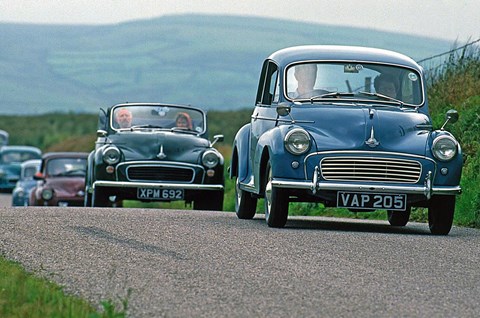► A love letter to the Morris Minor
► Mark Walton’s ode to the Brit icon
► Just as important as the
Who remembers Exchange and Mart? It does still exist as a website, though as a household name it’s been usurped by the likes of eBay and Auto Trader. My dad was a car enthusiast before me, and he used to buy Exchange and Mart every week, to thumb its densely packed pages (no pictures!) in search of cars. Consequently, I grew up driving all sorts of old dross that would come and go on the farm: an Austin Champ, a Peugeot 304, a Mini pick-up, a Mk1 Polo, a Jaguar 420G… eclectic, eccentric and always cheap.
One that hung around for a while was a Morris Minor, and I’ve had a soft spot for Minors ever since. It’s a car ill-treated by history – it was designed by Alec Issigonis, father of the Mini, yet while the Mini is seen as a Modernist masterpiece, the automotive equivalent of a man on the Moon, the Minor is… what? A Tudor cottage, complete with thatched roof and a box of clotted cream fudge in the glovebox. The Minor was launched 70 years ago, so – as it’s the anniversary – I thought I’d start a campaign to have it recognised for what it really is: every bit as subversive and avant garde as the Mini in its day.
My crusade would be easier if the dear old Moggy had kept its original codename: the Mosquito. Named after the racy fighter-bomber that entered the war in 1941, the new Morris project began in 1942. It was commissioned by Miles Thomas, head of Morris Motors, who gave the job to a 36-year-old Greek immigrant called Alexander Arnold Constantine Issigonis. Morris was part of the Nuffield Organisation, still headed by its founder, William Morris himself, Lord Nuffield. Nuffield was an old-school Victorian industrialist, and he didn’t like Issigonis, who he referred to as ‘Issy-wissy’, ‘Issy-what’s-his-bloody-name’ or more usually, ‘that foreign chap’.
But Thomas recognised a spark in Issigonis, who’d joined Morris in 1936 and proved himself a talent in suspension design. The Mosquito was to be ‘the foreign chap’s’ first major project.

Sketching his ideas in a notepad, which were then translated into detailed drawings by Jack Daniels and Reg Job, Issigonis would later proudly claim: ‘I designed the whole car myself, even the little knob that opens the glovebox.’ And knowing what we know now about the Mini, his fingerprints are all over it: a state-of-the-art monocoque shell (very new in its day), beautifully packaged and wholly dedicated to passenger space; the radical use of small, 14-inch wheels that had to be specially commissioned; advanced independent suspension and rack-and-pinion steering for great handling, despite it being a budget ‘people’s car’. Issigonis also worked on a new, 800cc flat-four boxer engine for his Mosquito, though this was eventually ditched in favour of an outdated side-valve unit. The whole thing was fabulously pure and austere: at launch, it only had one windscreen wiper and one rear light.
Then there’s the styling: far from being a cosy National Trust cottage with doilies and home-made plum crumble, the Minor was rebellious and futuristic. Inspired by American cars, it did away with running boards and mounted the headlights down in the grille. Nuffield hated it, describing it as ‘a poached egg’. Incredibly, after a couple of prototypes had been built, Issigonis decided it was too narrow, so he had a body cut in two, then he moved the two halves apart until it looked right, and welded a four-inch strip down the gap. The stretch was mostly hidden in the production design, though you can still see a stripe down the middle of the bonnet.
Best of all, the Minor was – and still is – brilliant to drive. Issigonis did the testing himself, heading off to North Wales with his flat-four Mosquito prototype. Seventy years later, a Minor’s steering still feels amazingly alive and accurate, and the handling is beautifully poised and stable. There’s no soft fudge in its direct mechanical communication.
Convinced? I know, it’s hard to look at a crusty old classic and see a revolutionary – especially when crusty old Lord Nuffield won the battle over the name. But the Morris Mosquito really was the Mini before the Mini, and it deserves to share its edgier reputation.
More blogs and columns by Mark Walton